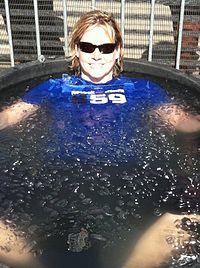冰浴
冰浴指人們將人體的大部分泡入冰水中一段時間[1][2]。通常人們是在劇烈運動後會將身體泡入冰水中[3]。不過把身體泡入冰水中會有一定的概率罹患失溫症[4],也可能會導致休克[5]並心搏停止[4][6][7]。

參考文獻
編輯- ^ Photo Replay. The New York Times. July 28, 2011 [2011-08-13]. (原始內容存檔於2017-11-07).
Daniel Ianus of Romania's national rugby team took an ice bath after a training session ...
- ^ Yael Averbuch. No Tweeting From the Ice Bath. The New York Times: Soccer. 2011-04-28 [2011-08-13]. (原始內容存檔於2018-10-21).
I tell my body to do a lot of things: Run one more sprint. Strike 50 balls. Push through just 15 more minutes. Warm up. Cool down. Sit in an excruciating ice bath.
- ^ Note: This article only refers to the use of ice baths in sports therapy and not to their use in cold exposure programs like the Wim Hof Method where ice baths are of different temperatures and are used differently.
- ^ 4.0 4.1 Tipton MJ. The initial responses to cold-water immersion in man. Clinical Science. 1989, 77 (6): 581–8 [2023-07-25]. PMID 2691172. doi:10.1042/cs0770581. (原始內容存檔於2020-04-23).
- ^ Datta A, Tipton M. Respiratory responses to cold water immersion: neural pathways, interactions, and clinical consequences awake and asleep. Journal of Applied Physiology. 2006, 100 (6): 2057–64. PMID 16714416. doi:10.1152/japplphysiol.01201.2005.
- ^ Shattock MJ, Tipton MJ. 'Autonomic conflict': a different way to die during cold water immersion?. The Journal of Physiology. 2012, 590 (14): 3219–30. PMC 3459038 . PMID 22547634. doi:10.1113/jphysiol.2012.229864.
- ^ Heller K, Salata S. Cardiopulmonary arrest after cold water immersion and hypothermia. Journal of Emergency Nursing. 1988, 14 (1): 5–8. PMID 3279252.